
Thunder Valley Drums
by Bob Teets
Elizabethtown, KY
Click on any picture to see a larger version.
I've loved drums since childhood, and after retiring as a professional journalist and public relations practitioner, I set about following my dreams of being a drum maker in the old traditions common to both Native American and Celtic peoples. I have studied these cultures and their spiritual beliefs all of my life.
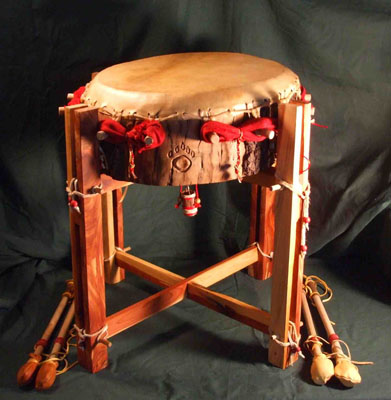
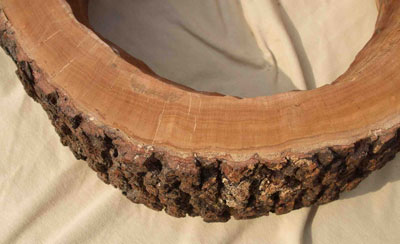
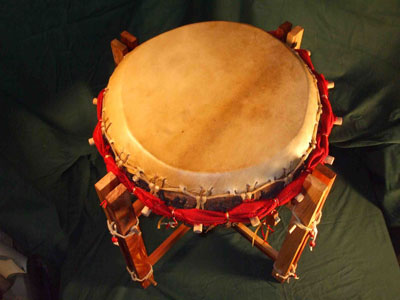
|
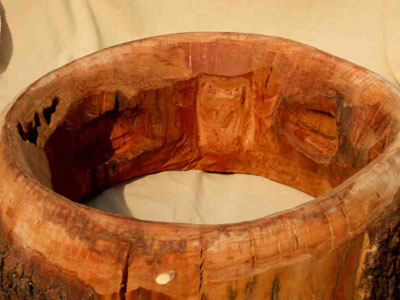
|
The "Bear Drum" shown in the above pictures is the largest I've made so far. It is a powwow type drum that can be played by many people at once. Solid cherry, it measures five feet in circumference with a frame about two inches thick. It contains lightning-struck wood, oak tie-down pegs, and two carvings, one on the outer surface of a bear paw, and one on the inside surface of a bear. There are four hollowed out pockets inside (made by using a wonderful Arbortech Power Chisel I purchased from Highland Woodworking!) in which to place herbs, seeds and other items, like ancient drummers used to do for healing circles. It sits on a drum stand made from red cedar that was recovered from a demolished 100-year-old barn.
When possible, I make drums and other items from trees struck by lightning, which some ancient cultures believed could imbue great healing energy into such instruments.
It takes a lot of patience working with lightning-struck wood, as millions of volts of electricity passing through it can literally cook it in a second. The high intensity charge follows concentrations and channels of water through a tree and will cause parts to explode or even to vaporize. Amazingly, though, some parts remain intact. This is generally the more dense wood which did not have much water in it at the time of the strike.
So once a round is cut to make a drum from it, the first order of business is to remove the pithy wood cooked by the strike because it is not strong enough to serve as a frame. Over time I've become more selective of pieces that remain intact on the outside and where most of the electricity passed through the center. Generally though I will still need to replace some bad sections with other pieces cut from the tree and shaped to fit into the frame.
If a tree is harvested relatively fresh from a strike, one will need to allow it to dry, as with any new logs. I recently started working drums from a maple tree we cut 16 months ago, and yet its moisture content is still elevated because the pithy wood, with a consistency similar to cork resulting from the strike, has a tendency to draw more moisture to it from surrounding wood, thus retarding its ability to dry. When that happens, mold and mildew tend to form too, presenting another challenge. I will often use a preservative to kill off the fungus while also stabilizing the wood. Sometimes a piece will have to sit for months if I do so, however.
I've used various methods to remove the centers of the rounds, from the oldest method of slowly burning them out with charcoal, to hacking, chiseling, and of course sawing. I much prefer the old methods because I feel as though I bond with the wood in a way that makes it a better instrument.
Once I have a frame finished, I then form the fine lip of the rim so the rawhide I use as a drumhead will seat properly and give the drum its hearty voice. That's one of the prime aims of making a good drum! There are reports from the 18th Century of special waterfilled drums made by Native Americans which could be heard over a distance of many miles, and were used for communications and as early warning systems.
I started selling lightning-struck drums and other items containing lightning-struck wood about 10 years ago, and have sent them around the world to people who do not have the means or time to make their own. More and more people are joining drum circles and even using drums during healing rituals, recalling the ancient days before doctors. Several scientific studies* in the past few years have demonstrated the efficacy of drumming to boost the immune system and to overcome a variety of maladies.
There is just something about playing a drum that can lift your spirits. And if you're of a mind, making a drum can be an ultimate thrill!
*Here is the link to an excellent article about drumming, and citing scientific research supporting the health benefits of drumming:
CLICK HERE
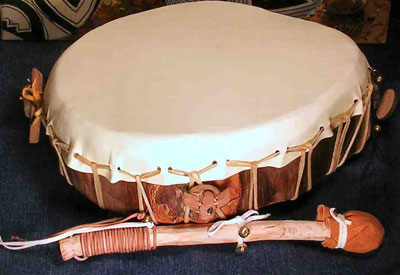
I occasionally make a drum from a tree not struck by lightning, although I will always add lightning-struck wood to it at some point. Here is my first drum made from sassafras, a wonderful wood to work with. The tree it came from, by the way, was ruined by insects. I only make drums from trees destroyed by natural causes.
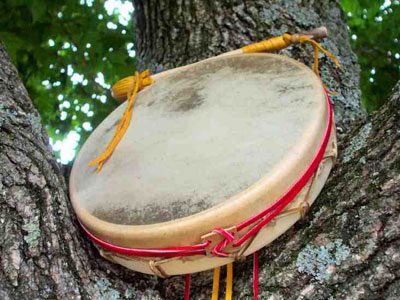
This hoop drum features a piece of lightning-struck cherry wood tied to the frame with red deer lacing.
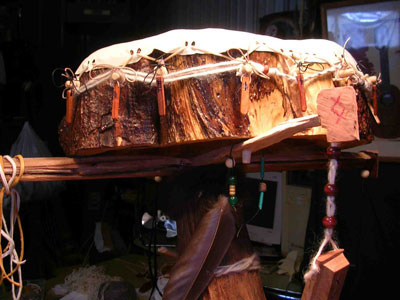
This large, not-quite-finished lightning-struck silver maple drum sits in my shop on a specially constructed stand made from a small locust tree stump topped with lightning-struck cherry wood crosspieces. Decorations include dangling lengths of cherrywood engraved with various Celtic alphabet letters, and a tiara of sheep and alpaca wool.
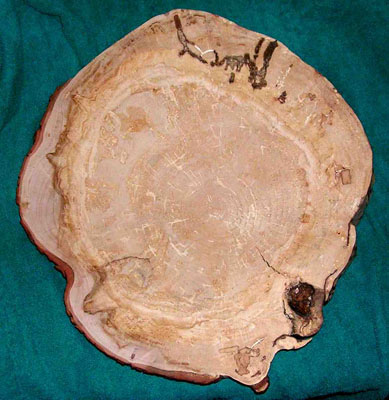
This cross-cut section of a silver maple is a prime example of how lightning can surge through a tree, yet not destroy it. The strike left a "lightning signature" (the squiggly irregular line at the top) where its power was concentrated. The center section was also "cooked" to a consistency similar to cork. For the most part, however, the outer portion of the round remained intact and became a very good drum frame after some cosmetic surgery removed the rotten knot hole near the bottom.
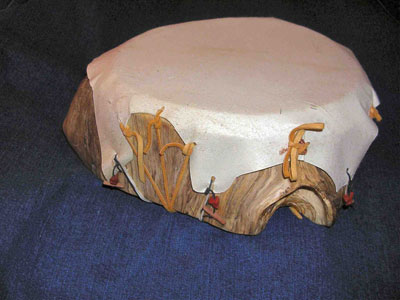
This beautifully burled lightning-struck hickory drum took months to dry and work, having sustained major damage from a lightning strike.
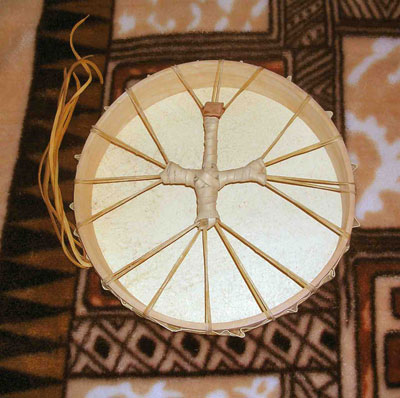
I also make hoop drums, using frames purchased from a Native American company, but tied in a unique way so that I may attach a piece of lightning-struck wood to form the head of a symbolic hummingbird, known in most cultures as a powerful symbol of joy.
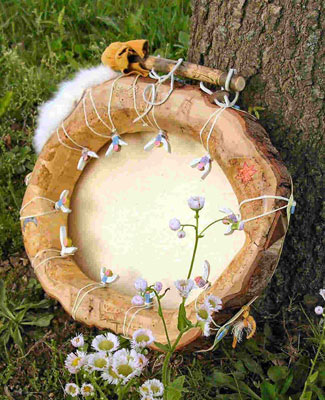
A personal favorite, the "11-Angels Drum" is quite unique in that half of the silver maple tree it came from was destroyed by lightning, so I sliced a piece in two and fused them together to make the frame. It features 10 carved angel figures which serve as pegs on which to anchor the drumhead. (The 11th angel is the one who plays it. She's in the kitchen right now!)
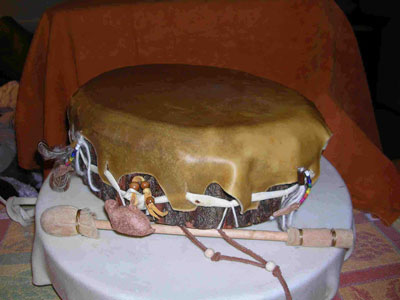
This primitive looking lightning-struck drum features an unbleached rawhide drumhead and many decorations.
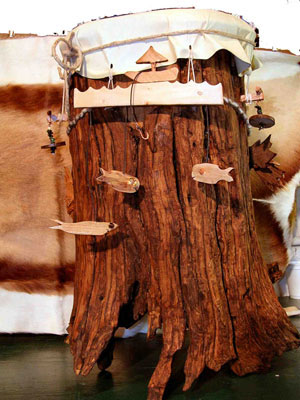
The Celtic Prince Drum was made from a red oak stump. This child's drum has many playful attachments made from lightning-struck wood that move, wobble or shake while the drum is played. There's a dragon, woodpecker, fish, and cross-cut apple tree branch discs studded with emerald chips.

An elaborate wooden decoration depicting the sun, Celtic Tree of Life, a lion's head and four retractable serpents form the top of drum stand for the "Sun King Drum." Various gemstones are attached to the serpents when you remove them. A medicine bag is secreted in the base, which was a locust stump.
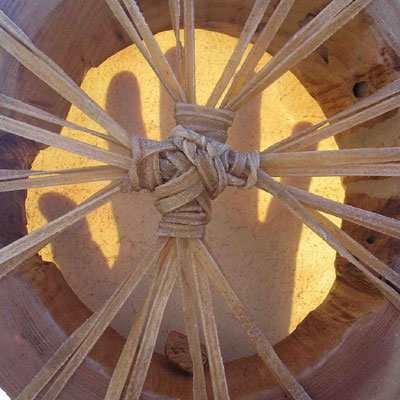
Rawhide drum heads are opaque, as shown by the silhouette of my hand showing through the center of this sassafras drum.
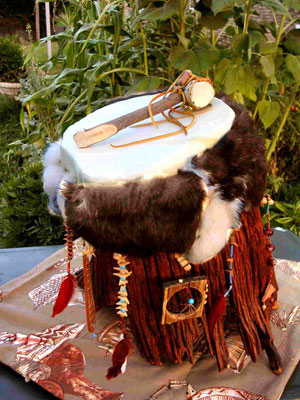
One of the first lightning-struck drums I ever made, the Grandmother Earth Drum, constructed from a red-oak stump. We continue to use her in our drumming circles.
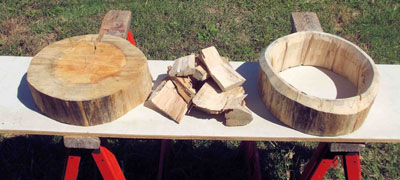
The two sections of lightning-struck maple here are different, but used to illustrate the progression necessary to make a frame.
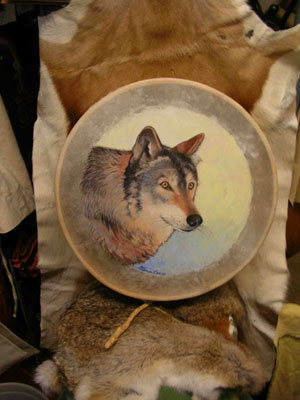
Many buyers like to have animals or other artwork painted on their drums, as with this painting of a wolf on a 15-inch hoop drum by the Thunder Valley Drums resident artist, Glenn Lewis.
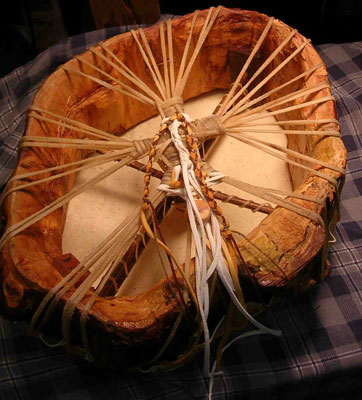
Often I will have to reinforce a lightning-struck frame with interior supports, as shown here.
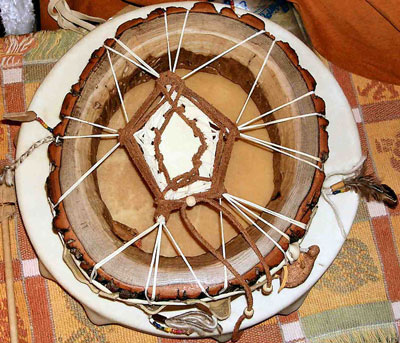
The Turtle Drum was constructed from a cross section of a sassafras tree and has lightning-struck and other handmade decorations.
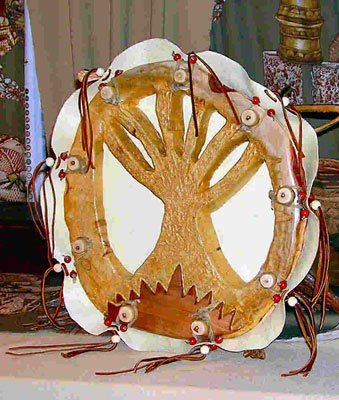
The Tree of Life Drum was made from lightning-struck silver maple and is not quite an inch thick. I used tie-down pegs made from lilac, and inlaid a sun symbol made from cherry.
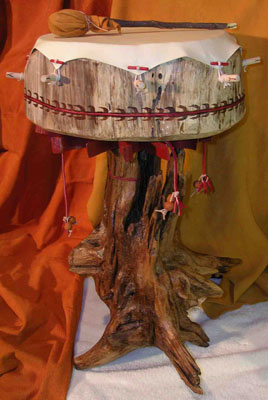
The Sun King Drum is made from lightning-struck hickory and rests on a locust stump drum stand. There is matching inlaid leather and hand-painted symbols on both pieces. The drumstand for this can be seen in earlier photos.
Bob Teets is a retired journalist and owner of Thunder Valley Drums, where he makes drums and other items, primarily from lightning-struck trees. He also teaches indigenous spirituality and drum making classes in Elizabethtown, Kentucky.
You can email Bob at
livefree@naturalshamandrums.com
or take a look at his website at
www.naturalshamandrums.com
or read his blog at
blog.naturalshamandrums.com
Return to
Wood News
front page

